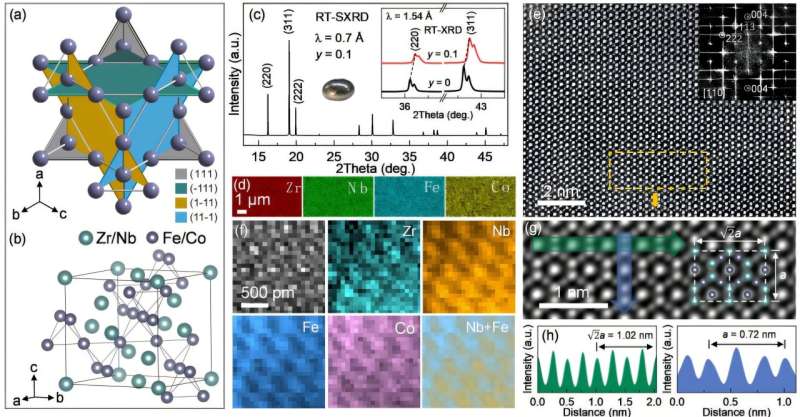Most metals expand when their temperature rises. The Eiffel Tower, for example, is about 10 to 15 centimeters taller in summer than in winter due to its thermal expansion. However, this effect is extremely undesirable for many technical applications.
For this reason, scientists have long been searching for materials that always have the same length regardless of the temperature. Invar, for example, an alloy of iron and nickel, is known for its extremely low thermal expansion. How this property can be explained physically, however, was not entirely clear until now.
Now, a collaboration between theoretical researchers at TU Wien (Vienna) and experimentalists at University of Science and Technology Beijing has led to a decisive breakthrough.
Using complex computer simulations, it has been possible to understand the invar effect in detail and thus develop a so-called pyrochlore magnet—an alloy that has even better thermal expansion properties than invar. Over an extremely wide temperature range of more than 400 Kelvins, its length only changes by about one ten-thousandth of 1% per Kelvin. The research is published in the National Science Review.
Thermal expansion and its antagonist
“The higher the temperature in a material, the more the atoms tend to move—and when the atoms move more, they need more space. The average distance between them increases,” explains Dr. Sergii Khmelevskyi from the Vienna Scientific Cluster (VSC) Research Center at TU Wien. “This effect is the basis of thermal expansion and cannot be prevented. But it is possible to produce materials in which it is almost exactly balanced out by another, compensating effect.”
Dr. Khmelevskyi and his team developed complex computer simulations that can be used to analyze the behavior of the magnetic materials at finite temperature on the atomic level. “This enabled us to better understand the reason why invar hardly expands at all,” says Dr. Khmelevskyi. “The effect is due to certain electrons changing their state as the temperature rises. The magnetic order in the material decreases, causing the material to contract. This effect almost exactly cancels the usual thermal expansion.”
It had already been known that the magnetic order in the material is responsible for the invar effect. But only with the computer simulations from Vienna, it became possible to understand the details of this process so precisely that predictions for other materials could be made. “For the first time, a theory is available that can make concrete predictions for the development of new materials with vanishing thermal expansion,” says Dr. Khmelevskyi.
The pyrochlore magnet with Kagome planes
In order to test these predictions in practice, Dr. Khmelevskyi worked together with the experimental team of Prof. Xianran Xing and Ass. Prof. Yili Cao from the Institute of the Solid State Chemistry of the University of Science and Technology Beijing. The result of this co-operation has now been presented: The so-called pyrochlore magnet.
In contrast to previous invar alloys, which only consist of two different metals, the pyrochlore magnet has four components: Zirconium, niobium, iron and cobalt. “It is a material with an extremely low coefficient of thermal expansion over an unprecedentedly wide temperature range,” says Cao.
This remarkable temperature behavior has to do with the fact that the pyrochlore magnet does not have a perfect lattice structure that always repeats itself in exactly the same way. The composition of the material is not the same at every point, it is heterogeneous. Some areas contain a little more cobalt, some a little less.
Both subsystems react differently to temperature changes. This allows the details of the material composition to be balanced point by point in such a way that the overall temperature expansion is almost exactly zero.
The material could be of particular interest in applications with extreme temperature fluctuations or precise measuring techniques, such as in aviation, aerospace or high-precision electronic components.
More information:
Yanming Sun et al, Local chemical heterogeneity enabled superior zero thermal expansion in nonstoichiometric pyrochlore magnets, National Science Review (2024). DOI: 10.1093/nsr/nwae462
Provided by
Vienna University of Technology
Citation:
Metal alloy shows practically no thermal expansion over extremely large temperature interval (2025, February 3)
retrieved 3 February 2025
from https://phys.org/news/2025-02-metal-alloy-thermal-expansion-extremely.html
This document is subject to copyright. Apart from any fair dealing for the purpose of private study or research, no
part may be reproduced without the written permission. The content is provided for information purposes only.

